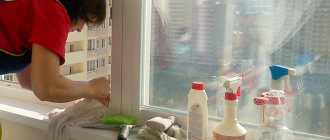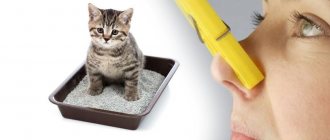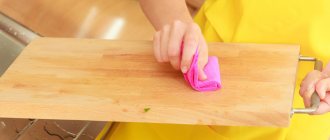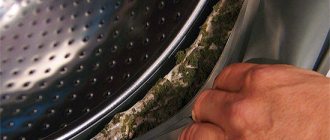The appearance of mold in the house may indicate possible problems with air ventilation and dampness in the room. It usually appears in the bathroom, kitchen, ceiling, walls. When favorable conditions arise for it, it appears on the walls of the wardrobe and storage shelves. How to get rid of mold in your clothes closet, as well as how to avoid the spread of infection, these questions take many by surprise. If a fungal infection (mold) is detected, it is necessary to urgently take action to eliminate it, since, in addition to damaging things, it causes serious respiratory diseases. What is the impetus for the development of fungal plaque? I recommend reading “Mold Allergy.”
Causes of fungus and unpleasant smell in the closet
Many people have experienced a situation where, when opening a wardrobe, an unpleasant smell of rottenness and dampness appears. People immediately begin to “escape” the smell of dampness with the help of special aerosols, but few think about how to get rid of the reason for its appearance in the closet. Under what conditions can a mold smell appear in a closet and the reasons for its occurrence:
- lack of access to fresh air;
- increased humidity;
- presence of stale, dirty clothes in the wardrobe;
- smell of tobacco smoke;
- storage of vintage clothing.
All of these factors become the main reasons for the appearance of fungal plaque, and also serve as hotbeds for mold.
How to treat kitchen cabinets?
Kitchen furniture, including household appliances, are also susceptible to mold odors. The first thing you need to do is wash the surface using a solution of water and laundry soap or bleach. Treat the doors, shelves, and walls with the composition.
As an alternative, you can use a vinegar solution, which is prepared using slightly warm water with the addition of seven tablespoons of vinegar. Put on gloves, treat work surfaces with vinegar solution and open the window wide. It is better not to enter the kitchen for several hours, and then you need to wash the surfaces with clean water.
After such procedures, do one of the most attractive things for you:
- Place saucers with coffee beans on the shelves. You can also use ground, but it must be natural. Soluble “sand” will not capture odors as well.
- Place 5 slices of fresh lemon in saucers and place on each shelf. Use the skins and zest too. Lemon absorbs odors perfectly.
- A small bowl of baking soda will absorb unpleasant odors in 3 days. Place containers in the farthest corners.
Sometimes housewives use aromatic products, for example, essential oils, but in the kitchen you need to be careful with this and use it only for walls and floors. In the same place where the products will be placed, the option with essential oils is not suitable.
Fungus and dampness are usually associated with living in an old house, but this is a misconception. Mold in the linen closet most often appears due to insufficient air circulation in the room. This problem is especially common among residents of private houses, although recently apartment owners have also been attacked by mold.
- Increased level of humidity in the room.
- Insufficient sealing of furniture and walls, adhesion of the walls of the old cabinet to the external wall of the house.
- Storing poorly dried clothes on shelves.
- Features of the chemical composition of fabrics.
- Poor quality materials and cabinet fittings.
A musty smell in kitchen cabinets is a sign that moisture has gotten inside or food is spoiling. They need to be taken out, spoiled ones should be thrown away. To remove the smell from the closet, wipe the shelves, inner surfaces of the walls and doors with vinegar. If the smell still remains, repeat the procedure.
Baking soda and vinegar are the most affordable remedies against unpleasant odors.
If the stench is strong, the shelves are fumigated with burnt sugar or dried citrus peels:
- Place a sheet of paper on a metal scoop and add 2-3 teaspoons of sugar. The sheet needs to be crumpled and set on fire. The aroma of smoke will not be very pleasant, but it neutralizes mustiness and quickly dissipates;
- Place the dried peel of a tangerine, orange or grapefruit on a scoop and set it on fire.
To finally deal with mustiness, several rye crackers, dried lemon, tangerine or orange peels are laid out on the shelves. Soda absorbs odors well. A vase of coffee, cinnamon, bay leaf, cloves or ground ginger will create a cozy atmosphere.
A musty smell may be a result of fungus attacking the cabinet walls. Most often, mold appears in furniture located near external walls. If this is the cause of the fungal attack, you need to either rearrange the furniture or treat the wall with a fungicidal agent.
You cannot put anything in a closet where mold has appeared until the fungus is completely destroyed. The affected area is wiped several times with hydrogen peroxide or boric acid. If the fungus appears again, use bleach. Deeply ingrained mold stains are scraped off, and the worn area is covered with varnish.
The products taken out of the cupboard are sorted out, the grains are fried (10–15 minutes in a hot oven). Cereals and pasta that smell moldy are thrown away. All dishes are washed in hot water with baking soda. In an apartment with high humidity, place bowls of salt in kitchen cabinets: it absorbs excess moisture well.
We suggest you read: How to remove sticky stains from clothes
The contents of the linen closet must be clean and dry. The smell of mold in the closet, and then the mold itself, can appear due to the fact that under-dried laundry was placed inside. Dry laundry that has been lying on shelves for a long time also smells unpleasant.
Once every six months, the entire contents of the cabinet should be removed and ventilated on the balcony in hot weather. To get rid of odors, wipe the inside surfaces of the walls and shelves with vinegar. If a fungus appears, the affected areas are treated with hydrogen peroxide, or in difficult cases with bleach.
Silica gel is an excellent prevention of high humidity and mold in the closet
Linen should be sorted out; if it is moldy or simply smells unpleasant, it should be washed. To keep your closet smelling fresh, place the following in piles of laundry:
- sachets with aromatic plants (lavender, rose petals, lilac leaves, mint);
- scented toilet soap (previously wrapped in cloth);
- empty perfume bottles;
- sheets of paper with perfume or essential oils applied to them (after applying the oil or perfume, the paper must be thoroughly dried).
Often the cause of an unpleasant smell from the wardrobe is the habit of some people of keeping clean clothes and stale clothes together. The smells of sweat and deodorants permeate clean clothes. If a smoker has such a habit, the smell of tobacco from the closet is guaranteed.
A musty smell occurs when undried outerwear is hung in the closet. If the furniture is too close to the outer wall of the house, mold will appear inside the cabinet. They fight mustiness and fungus in the same way as in the previous case: treat the walls with vinegar, wipe the mold stain with hydrogen peroxide (it can discolor the veneer, so first you need to test it on an inconspicuous area).
If the smell of mothballs is firmly ingrained in the wood of old furniture, mustard powder will help. It is scattered along the bottom and hung in the corners in bags made of thin cotton fabric. The doors are closed, and after 3-4 days the mustard from the bottom can be swept away.
Place jars of soda in the corners of the closet: it absorbs odors well. To reduce humidity, place silica gel packets along the bottom and in shoe boxes and place a jar of salt. A proven remedy against tobacco aroma is lavender. Also, the smell of tobacco smoke is effectively absorbed by wet fabric. Just hang a damp towel on the bar and close the doors. After an hour, the towel is changed. The procedure is repeated 3-4 times.
To keep ventilated items fresh, sachets with fragrant herbs are placed between the hangers. There is another way: tea bags are sprinkled with perfume or essential oils, dried and hung on a bar.
Tea absorbs odor no worse than other sorbents
- do not store clean and worn items after washing or dry cleaning together;
- Hang outerwear in the closet completely dry. During the wearing season, it is better to keep it on an open hanger;
- dry-cleaned items should be aired on the balcony for 1–2 weeks before hanging them in the closet;
- for sports, work, hunting, fishing, and tourist clothing, allocate a separate closet;
- If possible, change the insoles of winter shoes every season. Stuff shoe socks with newsprint; to neutralize the smell of sweat, place sachets with lilac leaves in drawers;
- do not store umbrellas in the wardrobe;
- do not smoke in the room where the wardrobe is located;
- Do not allow pets into the closet.
If you follow these simple rules, things in your closets will always smell fresh. To combat persistent odors, it is recommended to use special preparations, for example, OdorGone. Such products work faster than traditional ones, but the latter are more environmentally friendly.
Mold loves to thrive in dark and damp places. The basement, the lower part of the walls, the bathroom, and the kitchen are often invaded by a malicious fungus that poisons the lives of the residents of the house. If there is mold in the house, it can be detected by an unpleasant specific odor, the formation of dark spots, and the appearance of a coating in the form of white wool.
Often mold appears in flower pots due to excess moisture. It is not uncommon for a fungus to settle in a wardrobe. The worst thing is when the annoying moldy smell eats into your things. In this state they become unusable. How to quickly get rid of mold in a closet will be our topic of conversation today.
When you open the cabinet, the musty smell knocks you off your feet. This does not mean that the fungus has settled inside. It can be on the back wall, when the source is mold on wallpaper that has come off the wall, or under the floor. But sometimes it settles inside. An unpleasant odor spreads over long distances.
In order to choose the right weapon against a malicious enemy, you need to determine the source.
There are many reasons why mold appears in furniture, let’s look at them:
- Poorly dried items after washing, bed linen, kitchen towels. Dampness remains in the folds of tightly folded items for a long time, which means mold will appear instantly.
- The cabinet walls are closed very tightly and for this reason natural air circulation is disrupted.
- If there are fungal spores in the house and they fly in the air, then it can settle in any place where there are favorable conditions for it: dampness and darkness.
- It is difficult to detect mold in bookcases; only after the appearance of specific stains (brown, green, gray, etc.) can one determine the problem, which is caused by high humidity in the air.
- The most common health hazards found in kitchen cabinets are excessive dampness, accumulation of various food odors, darkness and lack of air.
The most unexpected places for mold to form
The appearance of fungal plaque is always accompanied by such factors as an increase in humidity and dampness, which is absorbed by furniture, walls, and ceilings. Due to its structure, mold fungus has an unlimited ability to penetrate deep into walls and furniture. The possibility of reproduction in a damp and humid environment increases several times, which results in a lightning-fast increase in lesions. Over time, clothing becomes infected. Rot in a closet can cause enormous damage to furniture and belongings. It is possible to detect mold only by completely checking the contents of things, the back wall of the cabinet, storage shelves, and the corners of the walls. Only after determining the location of the source of infection can we begin to eliminate the problem that has arisen. I recommend reading the article “How to get rid of mold in an apartment?”
Where to look for the source of mold?
Even if you smell mold in your closet, it doesn't mean it has spread there. The fungus lives in warm and humid places, which means it can be behind a closet wall, in peeling wallpaper, or right in clothes if they are not dried well.
The characteristic colors of mold are gray, green, blue, black. If you find it, immediately take measures to remove it, because the fungus spreads very quickly, affecting any surfaces along the way.
At first you will smell it and only after a while you will see the mold.
How can you tell if it's really the smell of mold if you can't see it yet? Its stench is bitter and damp.
Mold moves into closets with clothes from the following media:
- air ducts;
- rotten walls;
- the back of the furniture;
- rarely used books;
- carpet;
- mattresses;
- ceiling tiles.
Ways to solve the problem
How to get rid of mold in the closet and the appearance of an unpleasant odor will only help with the right approach to solving the problem. How to remove mold from a clothes closet? To do this, you will need to carry out the following activities:
- Cleaning. First you need to ventilate the dressing room. Then take out all the clothes and hang them outside to air. Particularly carefully, using a soda solution and a rag, carry out a wet treatment on the shelves and walls of the cabinet. Instead of soda, you can use a cleaning product. Dry the dressing room and repeat the procedure after 3-4 hours.
- The next step is to remove fungal plaque and its smell. To do this, you can use a vinegar solution (9%). Take vinegar, mix it with water (ratio 1:3), wipe the site of infection. Since vinegar has a specific smell, you can use hydrogen peroxide or boric acid instead.
- If mold reappears in your clothes closet, only a radical approach will help. Empty the wardrobe of clothes, and instead of vinegar and boric acid, use bleach based on chlorine in a ratio of 1:4 to water. Put on rubber gloves, moisten the cloth with the resulting solution and slowly treat the affected areas of the wardrobe. Dry, repeat the procedure after 2-3 days, the fungal coating will leave your chest of drawers for a long time.
The presence of smell and mold in the wardrobe and things is not the whole negative set of the problem that has arisen. After its appearance, the fungus infects clothing within a matter of hours. What to do if the mold that appears in the closet begins to actively reproduce on things?
How to eliminate fungus?
If mold is discovered, you need to urgently take measures to get rid of it, otherwise it will very quickly spread throughout all things and then it will simply be impossible to do anything about it and restore the damaged things. If the fungus appears on the walls of the closet, then it has definitely settled in the clothes.
In this case, you need to act like this:
- First, take all your clothes out to the balcony and hang them in the sun, turning them inside out so they don’t fade.
- Then treat the cabinet, namely, remove all plaque so that the problem does not return again.
- Once the items have dried a little in the sun, wash them using a special product that can remove the odor.
- Then dry them, iron them and you can put them back on the shelves.
How to save clothes from mold
The simplest microorganisms of the fungus begin to multiply intensively under favorable conditions. When interacting with clothing, they cause a destructive effect on fabrics and leave traces of their vital activity on them. These may be dark spots, colonies of fungal plaque. Fabrics lose their shine, color, and begin to unravel. It is possible to save things from the harmful effects of mold only in the first stages of infection. How to remove the smell from clothes from the closet at the initial stage of infection? There are several effective ways to do this:
- go to a dry cleaning salon;
- use special stain removers;
- traditional methods.
In the first case, things can be put into operation only if the time threshold for the appearance of plaque is no more than 14-16 days. Beyond these infection periods, the fabric loses its strength and breaks easily, which is why many dry cleaners refuse to work with it.
Second solution. Bleach can be used to remove mold stains, and Mellerud can also help. Before starting washing, it is recommended to test the selected product on a small piece of contaminated fabric.
Solving the issue using folk methods makes it possible to remove mold in the closet with clothes without the use of chemicals. To do this you will need a standard set of products, such as:
- curdled milk;
- vinegar;
- squeezed lemon juice;
- salt and others.
But before use, you need to know for what types of fabrics the listed types of products can be used.
The smell of new furniture
New cabinets almost always smell like varnish.
The evaporation of formaldehyde that is part of the chipboard can also add its own note to this sharp bouquet. If the furniture is of high quality, the smell will disappear within 2–3 weeks. If this does not happen, the owners will have to either return the purchase to the store, or constantly use odor absorbers. The new cabinet is installed in a well-ventilated area, the doors are left open. Weathering will speed up if you place cups of soda in the corners of the cabinet and tea bags (new or carefully dried used ones) on the shelves. If the smell does not completely disappear, you will need to keep the soda and tea in the cupboard constantly, changing them every 3-4 weeks.
Carry out the treatment only after the closet is completely empty of clothes. Today, there are several simple methods that can at the same time kill harmful spores and save wood from further damage. Let’s look at the 2 most effective ones.
The most common method is to treat wood with soda solution. This method is suitable even for a cabinet with children's underwear, as it is safe. Dissolve 3 tbsp in a liter of water. l. soda, then wash the inside of the cabinet with the resulting solution, including all sides, shelves, walls and doors. Leave the cabinet open for 4 days. You can also use hydrogen peroxide. Treating children's cabinets with peroxide is as safe as using soda.
Another effective method is chlorine bleach. But keep in mind that this method of dealing with the problem is not suitable for everyone, since chlorine causes an allergic reaction in many people. The method is suitable for processing a closet where the clothes of adult family members are stored. Carrying out such treatment is unacceptable for disinfecting children's furniture.
First, you should remove all clothes from the closet and dry the inner surface using a special dryer or fan, and only then proceed directly to disinfection. It is better to take the wardrobe out of the room into the open air so as not to breathe in harmful fumes.
Mix equal parts water and chlorine bleach, put on gloves and use the resulting solution to wipe all the walls and shelves of the cabinet, inside and out. When done, wash the cabinet with clean water. It is advisable for the wardrobe to stand for about 3 days in the fresh air, which will help eliminate the unpleasant smell of chlorine.
When processing wardrobes using this method, you do not need to add additional detergents to the water so as not to harm your health. Using bleach allows you to completely clean the surface, which ordinary soda, which is best used at the initial stage of infection, cannot cope with.
How to remove mold from a clothes closet using traditional methods
Stains on light-colored clothing are removed using hydrogen peroxide and liquids containing bleach. It is also recommended to use tableted vitamin C added to alcohol and vodka. After moistening a cotton swab in the resulting liquid, wipe the affected area.
Colored clothing requires the use of ammonia and water in a 1:1 ratio. After treating the stains with an ammonia mixture, wash with concentrated washing powder.
To remove stains and odors from natural fabrics, use fresh lemon juice and salt. Apply the solution to the stain and leave for 10-15 minutes, wash with regular powder.
To remove mold on woolen items, use turpentine and dry white clay. The area where the stain appears is treated with turpentine and sprinkled with clay powder, covered with paper and ironed with a hot iron. Afterwards wash with laundry soap.
Closet cleaning steps
Prepare the water; you can take a little essential oil for aromatization, the smell of which you like. It could be lavender and cloves that repel moths. As in the previous case, empty the closet of things, shelves and drawers. Take a thick bath towel, soak it in cool water and hang it in the closet for 1-2 hours.
- Prepare for cleaning: buy products for cleaning surfaces and washing clothes. If the case is advanced, purchase rubber gloves and a respirator that will protect you when using household chemicals.
- Take things out of the closet and put them aside - they will have to be washed. Open the doors and wipe all surfaces with a damp cloth. Open the windows, doors, balcony, if there is one - the room and furniture should be filled with fresh air.
- Start washing. If there are hopelessly damaged, torn or unnecessary items, throw them away. Wash the rest by hand or in the washing machine. Is the smell still on the items? Soak them in fabric softener for half an hour. Then wash again. This should be enough.
- Dry the clothes thoroughly and iron them. Place pieces of toilet soap on the shelves between the rows of clothes to make your closet smell nice. And now you can place everything in its rightful place.
- Use aromatics: coffee, tea bags, cinnamon, cotton bags of herbs, or anything else you like. They perfectly neutralize foreign odors and prevent the appearance of others.
Necessary actions to prevent fungal infection
To begin combating fungal mold, you need to make sure that the root cause of the mold has been eliminated. Since when the fungus is removed superficially, its reappearance is guaranteed. It is easier to prevent the occurrence of any contagious infections than to eliminate their consequences later. Preventative actions against mold:
- ventilate the premises (2-3 times a day);
- if necessary, it is necessary to install forced ventilation;
- during repairs and construction, use antiseptic preparations;
- monitor the condition of plumbing fixtures and, if necessary, repair damage or leaks that lead to dampness.
Mold prevention
Of course, after removing mold with various preparations, it is necessary to carry out preventive actions:
The inner surface of the wardrobe walls must be coated with waterproof varnish. The room where the furniture is located must be constantly ventilated. The more ultraviolet (sun) rays entering the room, the better. The plywood sheet covering the back needs to be replaced. To create additional ventilation, you need to drill several small holes at the bottom of the wardrobe. For good ventilation, cabinet doors must be kept open regularly. Dirty laundry should be kept far from clean clothes.
Reference! The above preventive measures can be made more effective. To get rid of an unpleasant odor, just install an aromatic sachet.
Many diseases are associated with the appearance of mold in the room. To prevent this from happening, you need to constantly monitor the furniture and check its condition. If you regularly carry out wet cleaning and use various disinfectants, you can minimize the likelihood of harmful mold appearing.
Furniture Wardrobe
Causes
Mold deposits that appear not only on cups, plates, and the walls of pots, but also in kitchen cabinets, in the bathroom, on the walls of rooms, and in various hard-to-reach places are an unpleasant sight. Black, greenish, pink spores of the fungus instantly grow in suitable conditions, posing a danger to human health.
Mold appears on dishes and other places for various reasons:
- high temperature and humidity in storage areas (on shelves, in cabinets, in drawers);
- lack of normal ventilation, airing, dampness in the room;
- careless drying of kitchen utensils;
- use of low-quality detergents.
Forgotten pieces of baked goods, leftover food in an unwashed pan in the kitchen - all this is excellent food for fungus. Two or three days in a warm place, and it is already “capturing” new objects. Having discovered contamination, it is necessary to very quickly remove mold from the dishes, thoroughly scrub, wash and be sure to treat the surfaces.
Harm to furniture, clothing and linen
Infected furniture smells unpleasantly damp. Over time, all wooden surfaces can become deformed, rot and fall apart. It’s good that this rarely happens, since it’s difficult not to notice the unpleasant smell and black, green, white mold spots on furniture for a long time.
Make sure that mold does not appear in the washing machine
Damage is also caused to the clothing inside:
- Spores from contaminated clothing can get into the washing machine, from there onto other things, and through them spread throughout the home.
- Things smell bad. Moreover, this causes not only discomfort. If there are a lot of spores in the tissue, then when they are inhaled, a person begins to sneeze.











